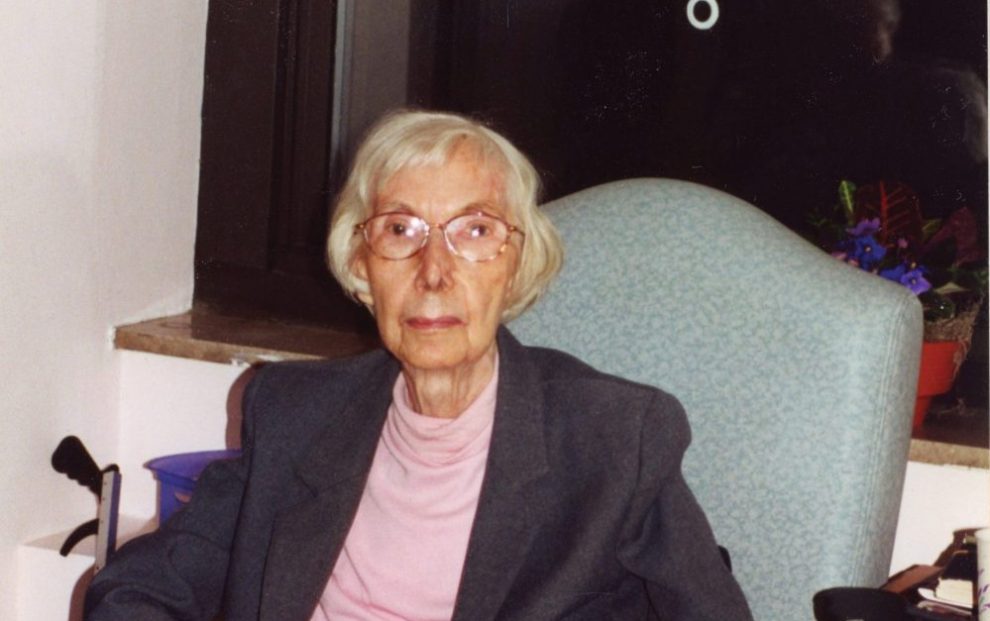When I was working on my memoir, Atchison Blue (Sorin Books), about my regular visits with the Benedictine Sisters of Atchison, Kansas, I met Sister Kathleen Egan, who became a cherished mentor. Sister Kathleen was a devoted social activist and helped found Benedictines for Peace. The first time I visited her room, my eyes were drawn to a black and white photograph of three women that hung on her wall. I recognized one of the women as Mother Teresa, now St. Teresa of Calcutta. The other was Catholic Worker founder Dorothy Day. I wondered: Who was the third woman with the large, dark-rimmed eyeglasses, high collar blouse, and page boy hairstyle?
That person turned out to be Eileen Egan, Sister Kathleen’s older sister. Egan was a close friend of both Mother Teresa and Day, and that particular photo proved significant. On that visit, Day walked Mother Teresa through the Bowery in lower Manhattan. Afterward, Mother Teresa promised to bring her Missionaries of Charity to New York to care for the alcoholics she saw in the streets.
Throughout her life, Egan remained an important link in furthering the works of mercy of both Mother Teresa and Day. Mother Teresa was canonized in 2016, and Day is now on a path to sainthood. Their stories are familiar to many worldwide, but Egan’s considerable contributions remain far less well-known. She worked largely behind the scenes, shunning the limelight. As a colleague once remarked, “She was someone you wouldn’t notice walking down a street. She wouldn’t stand out.”
It is Egan’s lifetime of work with the poor and marginalized that does stand out. Her efforts to promote peace and what she called “gospel nonviolence,” as well as her service to refugees and other marginalized people, left a significant mark on the history of the 20th century. Her trailblazing work with Catholic Relief Services, Pax Christi USA, and the Catholic Worker movement continues to influence peace and social justice activists to this day.
After seeing her photo that day, I made a point of reading all of Egan’s books and whatever articles I could find about her. The Egan family and her final personal assistant, Bernice McCann Doyle, graciously allowed me to review Egan’s personal papers with a view toward perhaps writing a biography of her. One passage in particular in Egan’s book, Suffering Into Joy (Servant Publications), stands out to me as an apt summary of her extraordinary life. She writes of going to India with Catholic Relief Services and encountering for the first time the ill and abandoned people whom Mother Teresa served on the streets of Kolkata:
“I knew the camps of the ‘displaced persons’ . . . I had talked with . . . survivors of the Holocaust, and I had listened to their stories of unspeakable suffering. Now in Asia, the face of suffering was intrusively and excruciatingly evident.”
What impressed me about Egan was that she didn’t present herself as a Christian heroine but as someone who struggled—as perhaps many of us would—to see the face of Christ in people who are diseased and downtrodden. She acknowledges how repulsed she felt the first time a leper reached out for her touch. “I was terrified, and I was so ashamed,” she writes in her 1985 biography of Mother Teresa, Such A Vision of the Street (Image Books).
“I felt this was something I had to come back to,” she concludes. And she did. She worked for several months beside Mother Teresa’s sisters, changing bed sheets, helping to wash people with leprosy, and giving comfort to the hopelessly ill.
From quite early in her life, Egan seemed destined to be in the right place at the right time for spreading gospel values. In 1943, she became the first laywoman hired by the precursor to what is now Catholic Relief Services. She helped resettle thousands of Eastern Europeans who had been living in displaced persons camps during World War II and continued her work with refugees from across the globe during more than 40 years with Catholic Relief Services.
Those encounters convinced her that war’s greatest cost is the suffering it brings to society’s most vulnerable: children, the elderly, and the poor. Egan envisioned a world united in communion. She saw it as the responsibility of Christians to recognize a common humanity that supersedes borders or nationalities. “All these other nationalities or identities are as nothing compared with the identity of being a member of the Catholic Church,” she writes.
Although Egan met thousands of refugees, she never viewed them as a category. She saw each as an individual reflection of God. Asked in a 1996 America magazine interview to relate a “moment of joy” from her refugee work, she told of witnessing the arrival in New York of the 100,000th displaced person from Eastern Europe. He was a Polish man who had been turned down several times previously for an American visa. Egan recalled that customs officials confiscated some fresh oranges the man had carried with him. Still, she said, he smiled as he headed for the airport exit.
Egan’s empathy for the marginalized was nurtured by her parents, Jeremiah and Mary Egan, themselves exiles of a sort—Irish natives who emigrated to Wales in search of work. The family lived in a town where there was no Catholic church, but Egan’s mother ensured her children were instructed in the faith. As an adult living in New York, Egan spent hours in prayer each day and attended daily Mass. Family tragedy only deepened her empathy. Within a few years of settling in the United States, both of Egan’s parents died, making her, their eldest, the matriarch of five siblings.
It was perhaps inevitable, then, that Egan would be drawn to the works of mercy of Mother Teresa. The future saint was unknown to the rest of the world when the two women first met in Kolkata in 1955. Egan arranged for Mother Teresa’s first trip to the United States to speak to a group of Catholic laywomen. Egan spent the next 17 years as Mother Teresa’s global traveling companion.
I admire Egan for her fearlessness in challenging the church’s hierarchy at a time when few Catholics dared to do so, particularly women. It was Egan who prodded, pushed, and ultimately helped convince bishops at the Second Vatican Council to denounce acts of war on civilian centers and affirm the right of conscientious objectors to refuse to participate in combat. These are accepted principles today, but in 1965 it was far from clear that church leaders would affirm them.
Egan teamed up with Day in those efforts. While Day and a group of 19 women fasted, Egan shuttled between bishops, handing each one letters offering a gospel-based rationale for both principles. As a member of the board of the International Thomas Merton Society, I was delighted to come across a series of letters that passed between Merton and Egan showing how both decided to use the term gospel nonviolence instead of pacificism in making the case to church leaders. Pacificism, both agreed, connotes an individual moral decision, while gospel nonviolence reflects a universal call to all Christians.
Her dedication to nonviolence was tested in 1992 when, at the age of 80, she was mugged on her way to Mass and suffered a broken hip and fractured ribs. She refused to testify against her assailant, a man with mental illness also suffering from homelessness, and often checked on his well-being when he was incarcerated.
Egan died of cancer eight years later on October 7, 2000. She was 88. The homilist at her funeral Mass rightly called her “the enfleshment of the Beatitudes.” I hope one day the church will open a cause for canonization for Egan, as it did for the two women with whom her life was so closely aligned. Egan no doubt would brush off such talk. May she always occupy her rightful place within this triumvirate of powerful women to whom we owe so much.
This article also appears in the July 2023 issue of U.S. Catholic (Vol. 88, No. 7, pages 45-46). Click here to subscribe to the magazine.
Image: Courtesy of the Egan family














Add comment